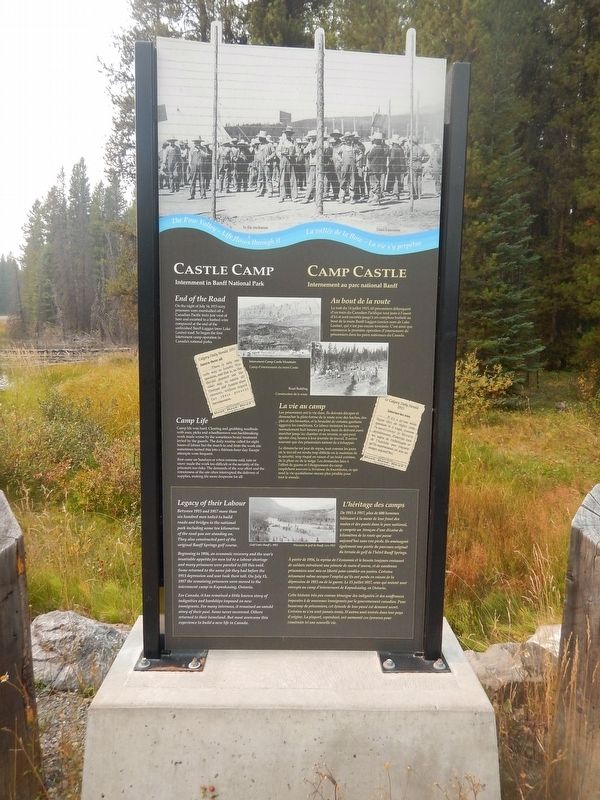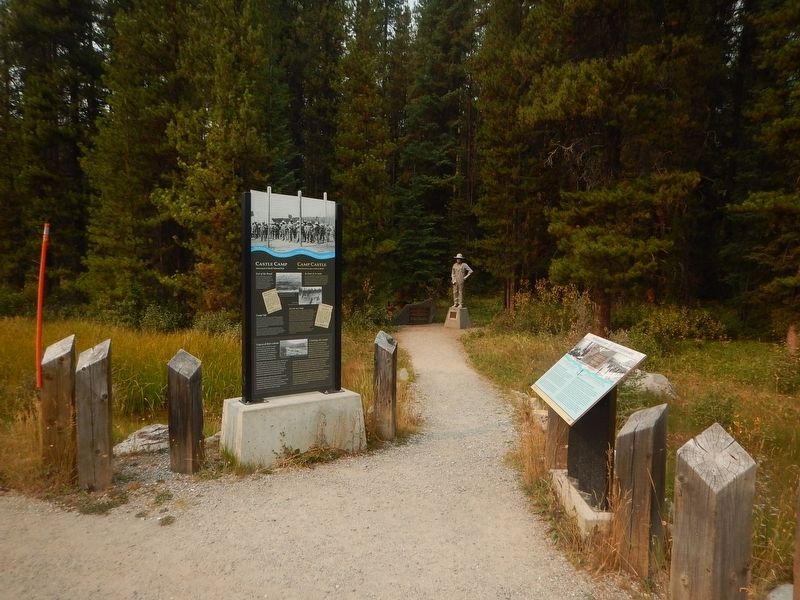Near Castle Junction in Banff National Park, Alberta — Canada’s Prairie Region (North America)
Castle Camp
Internment in Banff National Park
End of the Road
On the night of July 14, 1915 sixty prisoners were marshalled off a Canadian Pacific train just west of here and escorted to a barbed wire compound at the end of the unfinished Banff–Laggan (now Lake Louise) road. So began the first internment camp operation in Canada's national parks.
Camp Life
Camp life was hard. Clearing and grubbing roadbeds with axes, picks and wheelbarrows was backbreaking work made worse by the sometimes brutal treatment levied by the guards. The daily routine called for eight hours of labour but the march to and from the work site sometimes turned this into a thirteen-hour day. Escape attempts were frequent.
Rest came on Sundays or when extreme cold, rain or snow made the work too difficult or the security of the prisoners too risky. The demands of the war effort and the remoteness of the site often interrupted the delivery of supplies, making life more desperate for all.
Legacy of their Labour
Between 1915 and 1917 more than six hundred men toiled to build roads and bridges in the national park including some ten Kilometres of the road you are standing on. They also constructed part of the original Banff Springs golf course.
Beginning in 1916, an economic recovery and the war's insatiable appetite for men led to a labour shortage and many prisoners were paroled to fill this void. Some returned to the same job they had before the 1913 depression and war took their toll. On July 15, 1917 the remaining prisoners were moved to the internment camp in Kapuskasing, Ontario.
For Canada, it has remained a little known story of indignities and hardships imposed on new immigrants. For many internees, it remained an untold story of their past. Some never recovered. Others returned to their homeland. But most overcame this experience to build a new life in Canada.
Topics. This historical marker is listed in these topic lists: Notable Events • War, World I. A significant historical date for this entry is July 14, 1915.
Location. 51° 17.48′ N, 115° 58.068′ W. Marker is near Castle Junction, Alberta, in Banff National Park. Marker is on Bow Valley Parkway (Provincial Highway 1A) 4.3 kilometers west of Banff-Windermere Highway (Provincial Highway 93), on the right when traveling west. Touch for map. Marker is in this post office area: Castle Junction AB T0L 1E0, Canada. Touch for directions.
Other nearby markers. At least 3 other markers are within 16 kilometers of this marker, measured as the crow flies. Castle Mountain Internment Camp (here, next to this marker); Storm Mountain (approx. 1.9 kilometers away); Era of the Automobile / L'ère de l'automobile (approx. 14.9 kilometers away).
Also see . . . Wikipedia - Ukrainian-Canadian internment. (Submitted on October 16, 2017, by Kevin Craft of Bedford, Quebec.)
Credits. This page was last revised on January 23, 2022. It was originally submitted on October 16, 2017, by Kevin Craft of Bedford, Quebec. This page has been viewed 277 times since then and 21 times this year. Photos: 1, 2. submitted on October 16, 2017, by Kevin Craft of Bedford, Quebec.

